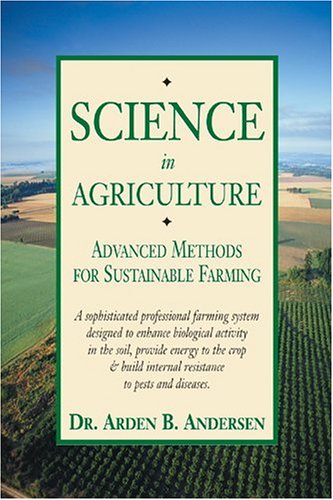 Dr. Andersen has written a comprehensive manual on creating and maintaining non-linear, harmonic and dynamically biologically diverse, mineral rich soil, free of pesticides, harmful fertilizers, deficient or excessive nutrients and able to sustain the growth of plants from seed to fruit while maintaining high brix readings and energy in both plant and soil.
Dr. Andersen has written a comprehensive manual on creating and maintaining non-linear, harmonic and dynamically biologically diverse, mineral rich soil, free of pesticides, harmful fertilizers, deficient or excessive nutrients and able to sustain the growth of plants from seed to fruit while maintaining high brix readings and energy in both plant and soil.
In the author's note dated August 2006, Dr. Andersen says: "Always be conscious of the fact that the purpose of agriculture is to produce food for people, and, thus, food must have comprehensive nutrition suitable for people..." When we are eating a salad at the dinner table we are eating the end product of a long chain of chemical and biological events that must be in balance. Dr. Andersen starts with an explanation of soil chemistry that takes us on a journey into the molecular structure of minerals and how and why they combine and re-combine in the soil. The second chapter in the book, "Chemistry", may seem a bit difficult at first because it explains the actual chemical action in the soil but he is a remarkably clear writer. This chapter introduces the reader to the names of the chemicals used in agriculture. For instance, in the name anhydrous ammonia, anhydrous means without water making the chemical very aggressive in its quest to combine with water which is why it "burns" when it gets on human skin, it is simply removing the water and killing the skin cells. It has unfortunate properties in the soil as well. In chapter 9, "Clay Chemistry", he mentions that anhydrous ammonia was used during World War II to harden the soil on runways to make the soil hard enough to land planes on.
Besides the chapters on basic soil chemistry Dr. Andersen covers plant function (chapters 6, 7, 8) and discusses a different paradigm of plant life and growth from the mechanistic, physio-chemical one that has become the norm. Replacing these ideas are the results of the work of Dr. Philip Callahan and Dr. Carey Reams, the most notable of the researchers in the field of plant energy. All living cells produced energy and as such, plants are electromagnetic organisms which depend upon appropriate electromagnetic energy to grow and reproduce. Paramagnetic is still a somewhat esoteric term but repeated experimentation has brought the term into the bio-farming vocabulary. Farmers, Dr. Andersen writes, want practical concrete concepts like liming, composting, tillage and so forth. Today, after many positive results from experimentation, it is easy to insure soils have effective paramagnetic qualities obtainable from the addition of paramagnetic rock powders, used with proper soil amendment and management. Dr. Carey Reams discovered biological ionization, RBTI or the Reams Biological Theory of Ionization. Reams taught that the function of nature is electromagnetic and primary to the chemistry of plants. He said plants grow through the process of ionization-similar to an electroplating machine and fertilization is electromagnetic in the balancing of positive and negative charges. Fertilizers, the minerals in them, work with opposite charges in the soil providing a release of energy which balance and build the electromagnetic fields in the soil and fuels plant growth. Dr .Reams found through experimentation that plants with proper mineral balance were not bothered by insect pests. He taught that diseases, insect problems and weeds were indications of nutritional imbalance. In his life he helped thousands of people regain their health through re-mineralizing their bodies (as well as other methods beyond the scope of this review). Reams prompted his students to see what they were looking at by which he meant to notice details and, more importantly, to consider them important messages from the soil, plants and animals.
Science in Agriculture is a multi-faceted book. Besides the pure science it is also a how-to manual for soil regeneration. Chapter 12 very practically tells us what various weeds are saying about mineral imbalance in the soils where they grow. Chapter 13, "Fertility Programming", is a short manual in its own right on how to restore a field to health. Chapter 16 explains foliar spraying and Chapter 17, "Management, Making it Happen", has good tips on accounting, goal setting and the "KISS" principle. There is also a chart of brix levels and an illustrated description of how to use a refractometer (brix meter). (Bees will not collect nectar from plants with a brix of 7 or less as it does not have enough energy to compensate the bees for the energy they use collecting it).
There is too much in this book to absorb in one reading and I am sure that was not Dr. Andersen's design. This is a basic text book for anyone interested in growing food with superior nutrition. This is a book to keep next to your favorite chair and read over and over until the ideas come naturally. You could even keep a computer near-by to study things in more depth. Heisenberg said, "What we observe is not nature itself, but nature exposed to our method of questioning". That's what we are doing, together, changing our method of questioning, re-interpreting old answers, and asking not, "What can we do", but "What is the best we can do?"

